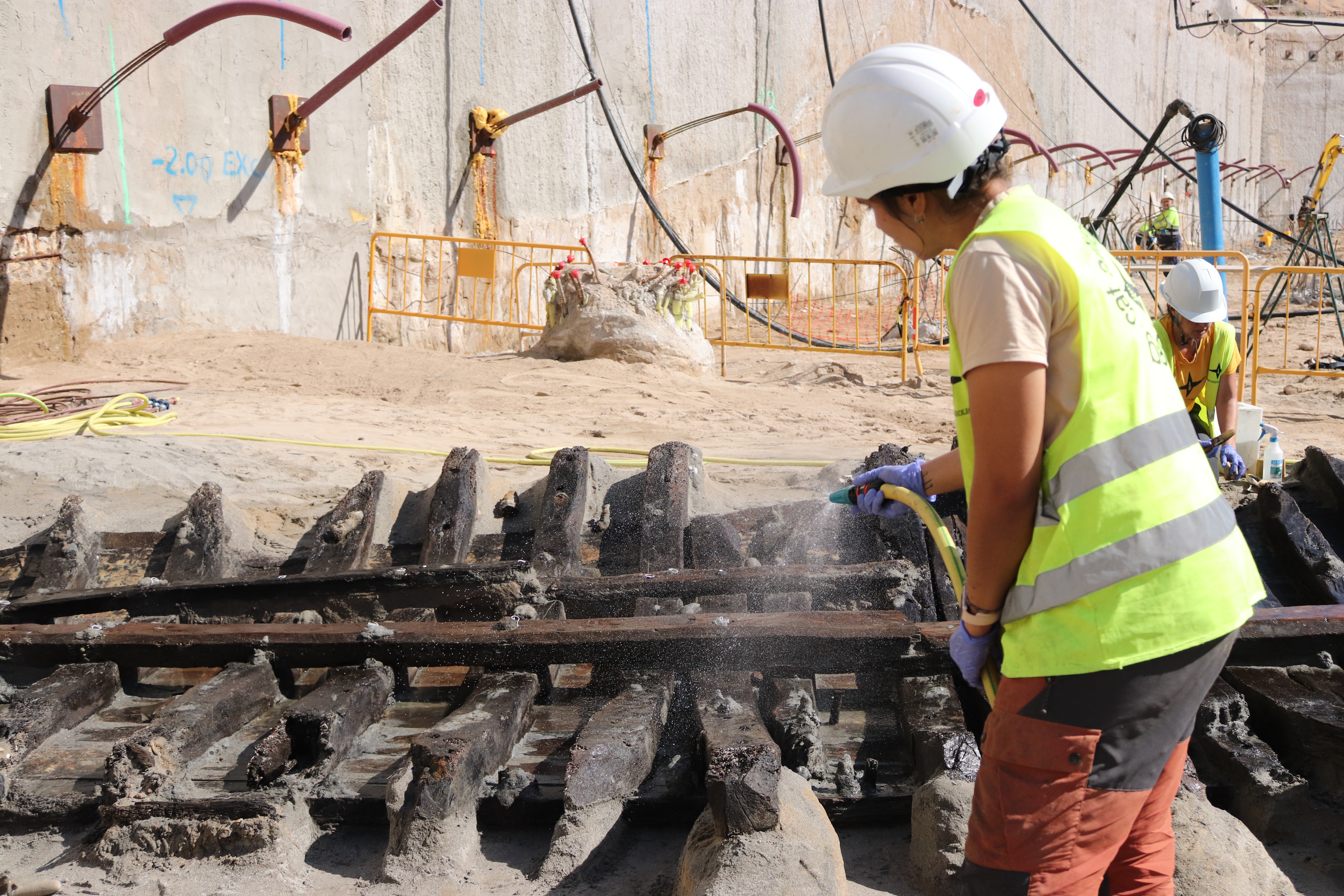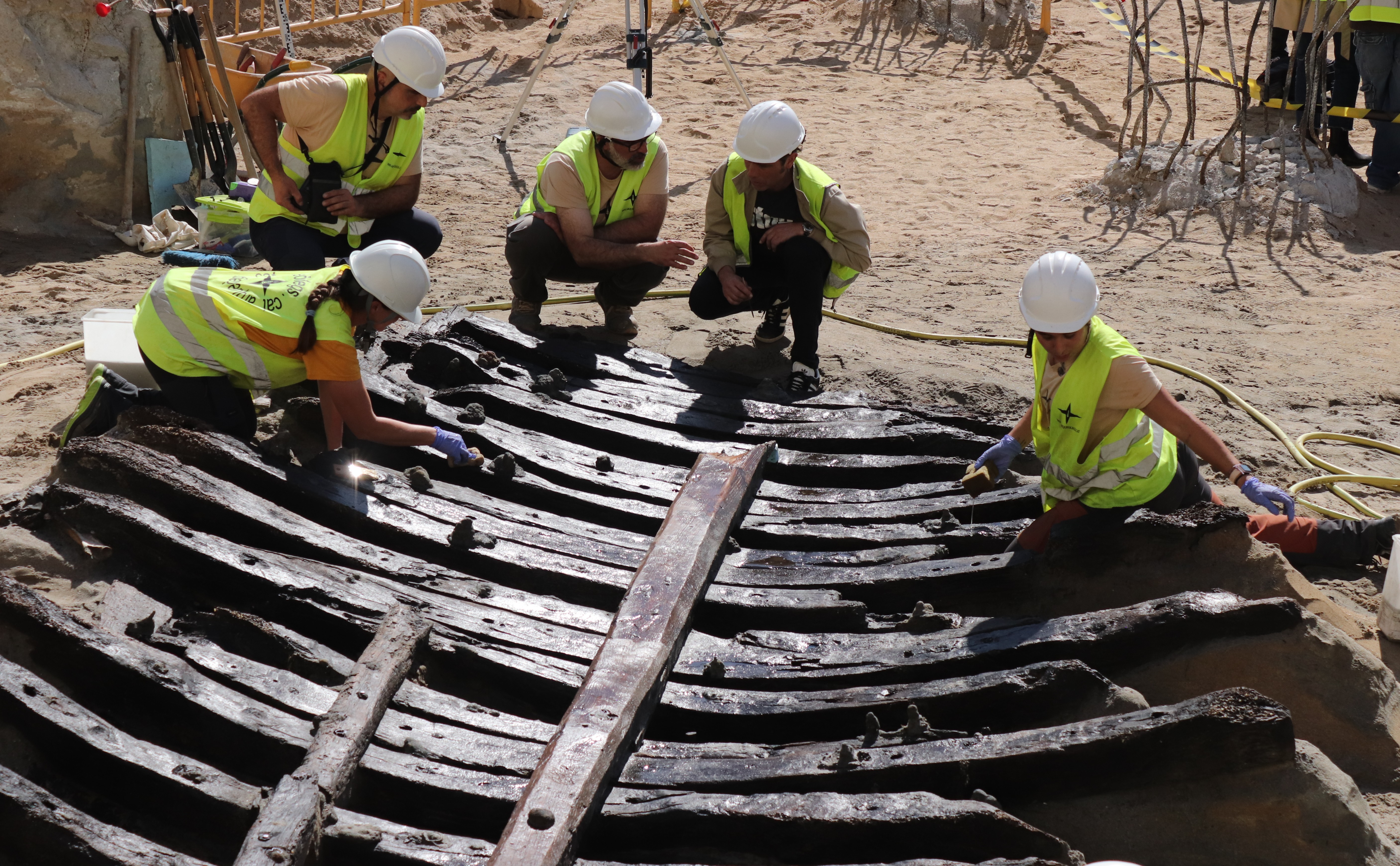Medieval Ship Found Beneath the Foundations of the Mercat del Peix
Medieval Ship Found Beneath the Foundations of the Mercat del Peix

The find occurred on April 8, during the final phase of the excavation and was documented by the team from Arqueòlegs.cat, under the direction of archaeologist Santi Palacios and restorer Delia Eguiluz, as part of an archaeological intervention initiated in March 2023. Since then, an air-raid shelter, archaeological remains from the 18th-century Bourbon Citadel, and elements of the 19th-century Mercat del Peix have also been uncovered. The second medieval ship documented in Barcelona was discovered a year after these finds.
The vessel has been temporarily named "Ciutadella I" and is currently located in the foundations of the Ciutadella del Coneixement, on the site of the former Mercat del Peix. This will be the future 7,000 m² research and innovation complex, where the new headquarters of the Institute of Evolutionary Biology (IBE: CSIC – UPF) will be situated as part of the "Ciutadella del Coneixement" project. The archaeological team believes that this is the stern of a large vessel, which must have been dragged by a storm to this location, which was covered by the sea during the 15th and 16th centuries.
“We anticipated that an archaeological remain of a ship might appear at this location, right next to the port and the artificial stone pier that protected it, a working area in the 15th and 16th centuries — and two years later, we’ve been lucky enough to find it,” says archaeologist Santi Palacios.

Archaeological team working on the shipwreck. Credit to IBE.
An Exceptional Find from Medieval Barcelona
In underwater archaeology, this type of find is called a "derelict," which refers to a shipwrecked or abandoned vessel covered by sediments over time. In this case, a 10-meter long and more than 3-meter wide fragment has been preserved, with a structure consisting of about thirty frames —the curved wooden pieces that make up the lateral skeleton of the ship— and at least seven planks from the hull, the rows of wooden boards that covered the exterior of the hull. The planks are nailed to the frames with wooden dowels of circular section, a type of wooden nails used to join the pieces. Two longitudinal pieces —keelson or saws— are also preserved, fixed with iron nails. This system, known as skeleton construction, was common in medieval Mediterranean shipbuilding and spread across Europe in the mid-15th century.
The only medieval ship previously documented in Barcelona was also from the 15th century and of Cantabrian origin. It is called “Barceloneta I” and was discovered in 2008 during excavations near the Estació de França. “Ciutadella I” is therefore the first Mediterranean-origin medieval ship found in Barcelona.
The archaeological team hopes to determine its place of manufacture through the analysis of the pitch (or resin) and wood from the remains.
The finding takes place within a historical context of the transformation of Barcelona’s waterfront. From 1439, with the construction of the first artificial piers, the dynamics of the coastline were altered, and the sandbar known as the Tasca, which had protected the city for centuries, disappeared. The combination of coastal drift, the Besòs river mouth, and storms caused rapid beach advancement, covering ancient maritime spaces. The area where the derelict has been located features very fertile sand and silt levels, with organic remains such as hazelnut seeds and whole pinecones, which are currently being studied, that could have a similar chronology to the ship.
A Very Delicate and Important Find
The remains of the ship are in a very fragile state of preservation. The waterlogged wood is extremely sensitive, and to prevent it from drying out and deteriorating, it has been partially covered with the original sand that surrounded it. The Archaeology Service of Barcelona, with the advice of the Museum of Archaeology of Catalonia - Subaquatic Archaeology Center of Catalonia (CASC), is working to ensure the correct documentation and conservation of the structure. Initial actions have consisted of taking samples for scientific analysis, marking structural elements, and applying techniques like photogrammetry, a methodology that allows the creation of high-precision 3D models from photographs, essential for recording the state and shape of the remains without handling them directly.

Archaeological team working on the shipwreck. Credit to IBE.
“The wood must be watered constantly to maintain its good condition. When we move it, we will need to take it piece by piece to continue its investigation,” explains restorer Delia Eguiluz.
The initial phase of the study includes precise technical work such as 3D documentation, marking of pieces, sample collection, and preparation for transport in water-filled containers, ensuring the temporary preservation of the remains. Later, the material will be transferred to specialized facilities, where desalination with running water and impregnation with water-soluble wax, a substance that penetrates the wood and strengthens its internal structure, will take place to ensure its long-term conservation.
This treatment is essential to preserve both the physical structure of the ship and its archaeological value, as it constitutes a unique source of knowledge about navigation and the shipbuilding techniques used in Barcelona during the 15th and 16th centuries.

Archaeological team working on the shipwreck. Credit to IBE.
Information about the Construction Works
The discovery of “Ciutadella I” occurred during the construction of a new facility on the site of the old Mercat del Peix, where the research and innovation complex will be built, and where the new headquarters of the Institute of Evolutionary Biology (IBE), a mixed center of CSIC and Pompeu Fabra University (UPF), will be located.
Located between the streets of Villena, Ramon Trias Fargas, Wellington, and Icaria Avenue, in the Sant Martí district, the parking lot built by the City of Barcelona and B:SM has a surface area of 7,000 m² and is conceived as a hub for sustainable mobility services that will serve the future research complex that will be built on top of the Biomedical Research Park of Barcelona (PRBB), CSIC, and UPF.
This initiative is part of the strategy for the “Ciutadella del Coneixement,” a scientific and urbanistic project aiming to transform the Ciutadella Park and its surroundings into a leading knowledge, dissemination, research, and innovation node in Europe.
